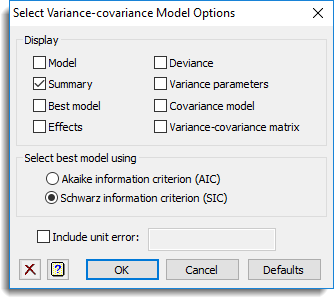Use this to set options when selecting the best variance-covariance model for a set of environments.

Display
This specifies which items of output are to be produced by the analysis.
| Model | Description of the model fitted by the analysis |
| Summary | A summary of the variance-covariance models fitted |
| Best model | Displays the best model |
| Effects | Estimates of regression coefficients |
| Deviance | The residual deviance |
| Variance parameters | Estimates of variance parameters |
| Covariance model | estimated covariance models in matrix format |
| Variance-covariance matrix | Variance-covariance matrix for the variance parameters |
Select best model using
This option specifies whether to assess the different covariance structures by using the Schwarz information criterion (SIC), which is also known as the Bayesian Information Criterion (BIC), or by using the Akaike information criterion (AIC).
Include unit error
When selected, you can supply a variate for the unit error to represent uncertainty on trait means (derived from individual unit or plot error) to be included in a QTL analysis. If a unit error data structure has been stored in the QTL data space then the name of that structure will be automatically entered into the input field.
Action buttons
| OK | Store the settings and close the dialog. |
| Cancel | Close the dialog without further changes. |
| Defaults | Reset options to the default settings. |
Action Icons
| Clear | Clear all fields and list boxes. | |
| Help | Open the Help topic for this dialog. |
See also
- QTL data space for using data in QTL menus
- Select best variance-covariance model menu
- VGESELECT procedure for selecting the best variance-covariance model for a set of environments in command mode